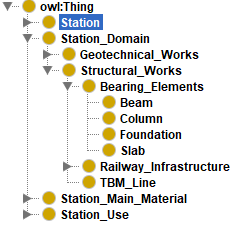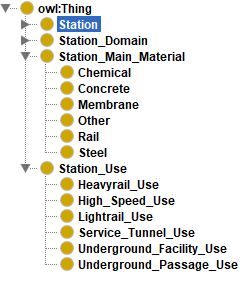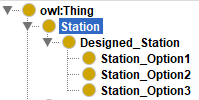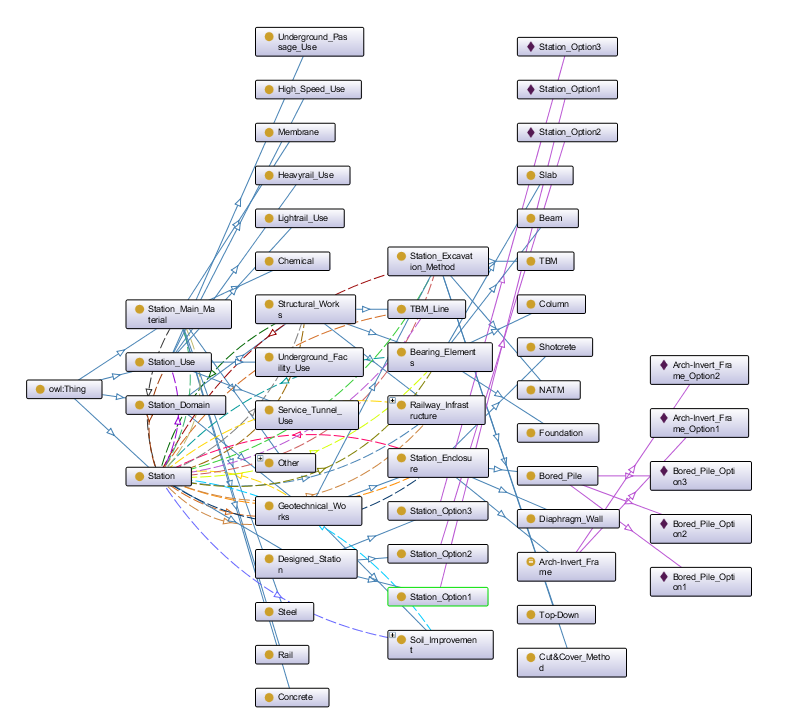Background
Subway stations are one of the main components of railway systems perform the connection between railway infrastructural systems and other systems, and also provide underground shafts for technical systems. Construction of a metro station consists of several different phases from the geological investigation of the site to the reinforced concrete structure, and electromechanical and tracking systems. our ontology will concentrate on creating a model for understanding information about the construction phases of a metro station and the relation between them as well as provide a platform where data could be used for different design options. Although there are many different types of subway stations, the ontology will be interested in the civil engineering domain of the underground metro, and the processes and interaction between both structural and geological works of a station. The project will also not focuses on areas such as electromechanical, signaling systems of a subway station, etc.
Ontology
The main civil engineering processes of a subway station construction are divided into two sections geotechnical works and structural works to be used in the ontology in the station domain class. The ontology includes also materials and the use of the station as different classes.
Figure 1: Project’s Main Scope
The station domain class is divided into two subclasses geotechnical works and structural works.
Geotechnical works consist of three other subclasses which are soil improvement, station enclosure, and excavation method. The soil improvement subclass is interested in soil improvement methods before the excavation process begins, and the preference of which method to be used is in accordance with the site investigations and laboratory tests. The subclass of station enclosure is concerned with the stabilization of the ground during and after the excavation process. The third subclass of
geotechnical works is the excavation method which consists of different types of excavation techniques for creating an area the station could be constructed.
Figure 2: StationDomain – Geometry Subclass
The station domain class is divided into two subclasses geotechnical works and structural works. Geotechnical works consist of three other subclasses which are soil improvement, station enclosure, and excavation method. The soil improvement subclass is interested in soil improvement methods before the excavation process begins, and the preference of which method to be used is in accordance with the site investigations and laboratory tests. The subclass of station enclosure is concerned with the stabilization of the ground during and after the excavation process. The third subclass of geotechnical works is the excavation method which consists of different types of excavation techniques for creating an area the station could be constructed.
Figure 3: Station Domain – Structural Subclass
Figure 4: Station Platform Level Plan
Other classes of the system are the main material which consists of all the materials in a metro station construction and the use of the station which is concentrating on the aims of the construction of a metro station.
Figure 5: Main Materials and Use of Station for Modeling in Protégé
For different station options, different property assertions can be defined. According to Ghazvinian et al, geological and urban circumstances could cause tunnel lines to be constructed in different depths, and besides budget boundaries, the depth of a metro station could also affect the length and width of a metro station along with other technical reasons. For different technical and monetary boundaries, the construction of a metro station could vary. For implementing this feature in our ontology model, individual data properties are assigned for each metro station option.
Figure 6: Design Alternatives
Figure 7: Design Option 3
According to the urban density and fragility, and geological features of a site, the construction technique and dimensions of a metro station could change. For example, if the metro station is to be constructed in an urban dense region, it may not be able to close the site from human traffic. In case
of a situation like that instead of NATM, TBM would be preferable. Although, if ground vibrations and deflections during construction need to be restricted and any ground movement would not be acceptable because of its deadly risks, a method to be used may be to cut&cover method. In our ontology modeling, there are three different metro station options and each of them is different in terms of dimensions, depth, and shape. The aim was to consider each option for different circumstances and different excavation methods. If the depth of a metro station to be constructed is not very high, the cut&cover method could be applied. In this option, railway tunnels are constructed by TBM. In the second option, the depth of the station increases to deeper than option 1. For this alternative excavation method is chosen as NATM, and for the railway tunnel, it is again TBM. In the last option, the metro station is at the deepest level and the method to be used for both the station and railway line tunnel is NATM. For different types of piles and arch-invert frames, different instances have been created. During NATM construction, differently sized tunnels are required and to provide transition and change between tunnels different arch-invert frames are required. Furthermore, changes in the depths of the station require different bored piles.
Figure 8: Design Option 1
Finally, the construction of a metro station from geotechnical improvements to final structural works is modeled. The ontology model covers the metro construction process in a wide frame since it consists of both ground intervention and stabilization methods and structural and infrastructural parts of an underground station. Using different subclasses provides a high level of variety in the construction of a subway station configuration. Interaction between different classes of metro construction can be seen in the figure below.
Figure 9: Final Ontology
REFERENCES:
Ghazvinian A., Monjezi M., Hadei M. R., Nejati H. R. and Sarfarazi V. (2011), A Global Review of Metro Station Construction Projects, First Asian and 9th Iranian Tunnelling Symposium November 2011.
Nicholson Peter G. (2015), Soil Improvement and Ground Modification Methods.
Paul V.K., Khursheed S. and Singh R., Comparative Study of Construction Technologies for Underground Metro Stations in India, IJRET International Journal of Research in Engineering and Technology, eISSN: 2319-1163 | pISSN: 2321-7308
Khan M. S., Park D. H., Kim D. H. (2016), System Modelling Approach Based on Data Acquisition and Analysis for Underground Facility Surveillance, Department of Computer Engineering Jeju National University, Jeju-Si, Republic of Korea
Guo H., A Review of Metro Tunnel Construction Methods, 2018 International Conference on Civil, Architecture and Disaster Prevention, doi:10.1088/1755-1315/218/1/012110








